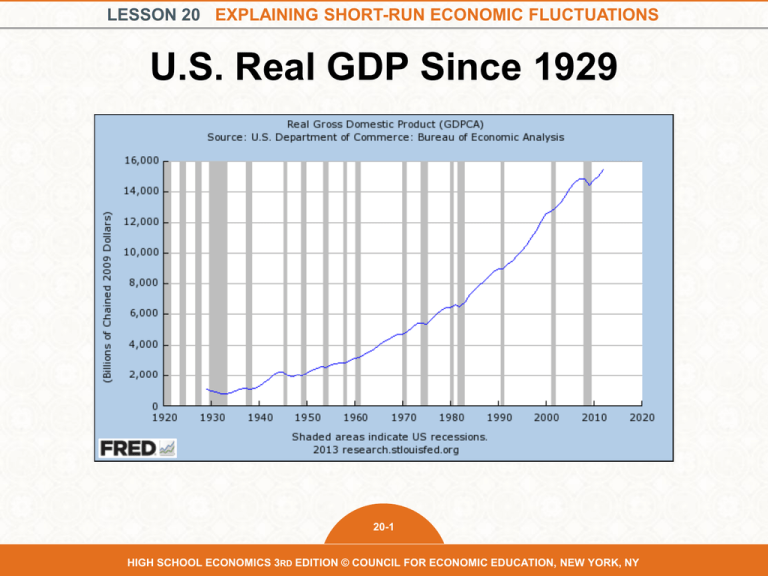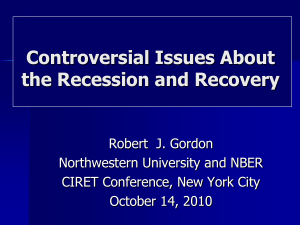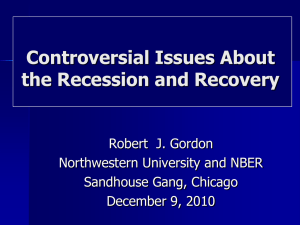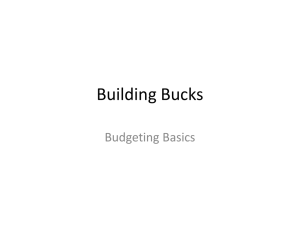Slides - High School Economics - Council for Economic Education
advertisement

LESSON 20 EXPLAINING SHORT-RUN ECONOMIC FLUCTUATIONS U.S. Real GDP Since 1929 20-1 HIGH SCHOOL ECONOMICS 3RD EDITION © COUNCIL FOR ECONOMIC EDUCATION, NEW YORK, NY LESSON 20 EXPLAINING SHORT-RUN ECONOMIC FLUCTUATIONS The Business Cycle 20-2 HIGH SCHOOL ECONOMICS 3RD EDITION © COUNCIL FOR ECONOMIC EDUCATION, NEW YORK, NY LESSON 20 EXPLAINING SHORT-RUN ECONOMIC FLUCTUATIONS Components of Total Spending Total Spending = C + I + G + (X – M) where: • C = Consumption spending by households on consumer goods and services • I = Investment spending by businesses on capital goods and services • G = Government spending by all levels of government for government-provided goods and services • X – M = Net export spending, which is spending by individuals and organizations outside the country on goods and services exported from it minus spending by individuals and organizations within the country on imports of goods and services from other countries; in other words, Net Exports = Exports (X) – Imports (M) 20-3 HIGH SCHOOL ECONOMICS 3RD EDITION © COUNCIL FOR ECONOMIC EDUCATION, NEW YORK, NY LESSON 20 EXPLAINING SHORT-RUN ECONOMIC FLUCTUATIONS Factors That Affect Total Spending in the Short Run C = Consumption G = Government • • • • • Desired rate of saving Level of tax rates Amount of wealth (value of assets owned such as houses, stocks, etc.) Level of consumer confidence in the economy • • I = Investment • • • National security concerns (defense) Need for infrastructure improvements (highways, sewers, communications, etc.) Demand for public services (education, police and fire protection, courts, etc.) X – M = Net Exports Borrowing costs, including the level of interest rates Expectations about future consumer spending Tax incentives or disincentives to invest • • • Growth of income and wealth of foreign buyers Prices in foreign nations relative to domestic prices Exchange rates 20-4 HIGH SCHOOL ECONOMICS 3RD EDITION © COUNCIL FOR ECONOMIC EDUCATION, NEW YORK, NY LESSON 20 EXPLAINING SHORT-RUN ECONOMIC FLUCTUATIONS Factors That Affect the Incentive to Produce in the Short Run • Availability/quantity of resources (human, capital, and natural) • Productivity of resources (output per unit of resource) • Level of direct taxes on business (e.g., corporate income tax and sales taxes on inputs purchased) • Level of government regulations on production (e.g., health, safety, and environmental requirements) • Prices of imported resources • Level of minimum wage • Amount of new innovations and inventions 20-5 HIGH SCHOOL ECONOMICS 3RD EDITION © COUNCIL FOR ECONOMIC EDUCATION, NEW YORK, NY LESSON 20 EXPLAINING SHORT-RUN ECONOMIC FLUCTUATIONS Answers to Activity 20.7 For Events 1–4: Total spending increases, real GDP rises, unemployment rate falls, price level rises 1. The federal government lowers income tax rates on households. 2. A positive outlook on future consumer spending leads businesses to build new factories. 3. Both the prices of stocks and houses rise. 4. Prices in Europe rise relatively faster than those in the United States. For Events 5–8: Total spending decreases, real GDP falls, unemployment rate rises, price level falls 5. Consumer confidence falls as households become more pessimistic about their jobs. 6. The federal government decreases expenditures on defense. 7. Interest rates are raised through actions by the Federal Reserve. 8. Slowdowns in the growth rates of China and India lead to lower U.S. exports. 20-6 HIGH SCHOOL ECONOMICS 3RD EDITION © COUNCIL FOR ECONOMIC EDUCATION, NEW YORK, NY LESSON 20 EXPLAINING SHORT-RUN ECONOMIC FLUCTUATIONS Answers to Activity 20.7 For Events 9–12: Incentive to produce increases, real GDP rises, unemployment rate falls, price level falls 9. The use of new technologies leads to increases in labor productivity. 10. The federal government lowers the corporate income tax rate. 11. Large reserves of oil are found in North Dakota. 12. A new invention creates numerous profitable opportunities to produce new products. For Events 13–16: Incentive to produce decreases, real GDP falls, unemployment rate rises, price level rises 13. The government increases the federal minimum wage. 14. The government imposes more stringent workplace regulations to better protect workers from injury. 15. The prices of imported rare earth minerals rise. 16. A hurricane destroys several large oil refineries in the Gulf Coast. 20-7 HIGH SCHOOL ECONOMICS 3RD EDITION © COUNCIL FOR ECONOMIC EDUCATION, NEW YORK, NY LESSON 20 EXPLAINING SHORT-RUN ECONOMIC FLUCTUATIONS Analysis of Real-World Events 1. (1979) The Organization of Petroleum Exporting Countries (OPEC) cuts its production, which raises the price of oil imported into the United States. Incentive to produce decreases, real GDP falls, unemployment rises, price level rises 2. (1981–1982) The Federal Reserve slows the growth of the money supply to fight inflation, which dramatically raises interest rates dramatically. Total spending decreases, real GDP falls, unemployment rate rises, price level falls 3. (1990–1991) The Gulf War leads to disruptions in oil supplies, which raise the price of oil imported into the United States. Incentive to produce decreases, real GDP falls, unemployment rate rises, price level rises 4. (1996–1999) The application of computer technologies to production processes greatly increases the productivity of labor. Incentive to produce increases, real GDP rises, unemployment rate falls, price level falls 20-8 HIGH SCHOOL ECONOMICS 3RD EDITION © COUNCIL FOR ECONOMIC EDUCATION, NEW YORK, NY LESSON 20 EXPLAINING SHORT-RUN ECONOMIC FLUCTUATIONS Analysis of Real-World Events 5. (2000–2001) Businesses dramatically cut back on expenditures for new computer systems after the threat passes of Y2K (fear that computers would not recognize Year 2000). Total spending decreases, real GDP falls, unemployment rate rises, price level falls 6. (2003–2005) The federal government sends military forces into Iraq in March 2003, beginning a multiyear peace-keeping effort. It lowers income tax rates retroactive to January 2003. Total spending increases, real GDP rises, unemployment rate falls, price level rises 7. (2008–2009) Households lose trillions in wealth after home prices and stock prices fall significantly. Total spending decreases, real GDP falls, unemployment rate rises, price level falls 20-9 HIGH SCHOOL ECONOMICS 3RD EDITION © COUNCIL FOR ECONOMIC EDUCATION, NEW YORK, NY









